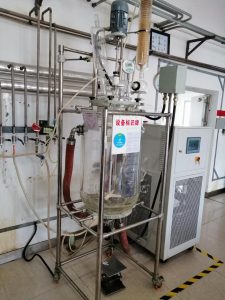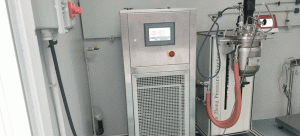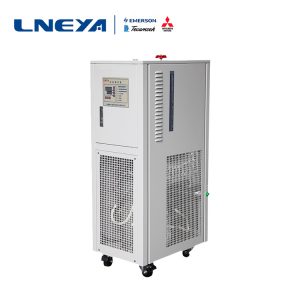Precautions for small laboratory water chiller before and after startup
In the pharmaceutical and chemical industry, small laboratory water chillers are widely used refrigeration equipment, which are often used in various reaction kettles for refrigeration reactions. In order to maintain the stable operation of the equipment, attention should be paid to the precautions before and after the start-up of small laboratory water chillers.
1、 Small laboratory water chiller before startup
1. Placement environment: when handling and moving the small laboratory water chiller, the body must be kept vertical and upward. Provide a stable fixed device to ensure that the small laboratory water chiller will not tilt. Ensure that the distance between the surrounding walls and the rear panel of the instrument and equipment is more than 70cm, and ensure that there is enough ventilation to allow the small laboratory water chiller to dissipate heat in time under the condition of high operation.
2. Notes on supporting connection: check the tightness of the connecting pipe interface between the small laboratory water chiller and peripheral equipment. Closed applications of external equipment (such as reactors) need to ensure that the material and performance of oil pipelines match the range of heat transfer oil and temperature. In order to ensure the correct operation of the small laboratory water chiller, it is necessary to ensure that no bubbles remain in the system, ensure that the outlet of the heat transfer medium is connected to the lower interface of the reactor, and the inlet of the heat transfer medium is connected to the upper interface of the reactor. Do not place tools, quantities, clamps, cutting tools, products and other items on the equipment.
3. Filling refrigerant: without special reasons, the small laboratory water chiller will not produce a large amount of leakage. If a certain amount of refrigerant leaks due to improper use or after maintenance, it is necessary to add refrigerant again. Pay attention to the refrigerant model used in the unit when filling refrigerant.
4. Filling heat conducting fluid: heat conducting medium. Water cannot be used for heat conducting medium. See the emptying and filling operation instructions for the filling steps. Check the working conditions of all parts for abnormalities and sounds during the power on test run
2、 Small laboratory water chiller in use
1. The small laboratory water chiller should be prepared before starting up as above. After filling the heat-conducting medium and exhausting, set the temperature and start the operation key to start the temperature control.
2. When starting, pay attention to whether the temperature, pressure, liquid level, hydraulic pressure, air pressure, electrical system, air pressure system, instrument signal and other protections of the small laboratory water cooler are normal. In case of any abnormality, stop the machine immediately for inspection until the cause is found out and eliminated.
3、 After the small laboratory water cooler stops
1. Before the small laboratory water cooler is shut down, wait for the equipment to return to normal temperature;
2. Power off through the program: click the “stop” button in the main control window, and power off directly after the unit components completely stop working.
3. When the small laboratory water cooler stops working, all operating handles, etc. should be placed in the non working position, the electrical control switches, knobs, etc. should be restored to the off state, and the power supply should be cut off
4. The small laboratory water cooler is clean and free of dirt, the processed parts are stored neatly, and there is no leakage at the interface of each transmission pipe.
5. If the small laboratory water chiller needs to be out of operation for a long time, and the ambient temperature of the equipment is lower than 0 ℃, the accumulated water in the system is easy to cause the cracking of the condenser components, so when shutting down, be sure to drain all the accumulated water in the small laboratory water chiller to prevent the pipeline from rusting or cracking, resulting in the damage of the condenser. And discharge the heat conducting medium inside the equipment.
During the use of small laboratory water coolers, they should be maintained regularly to maintain the accuracy and performance of small laboratory water coolers as much as possible and prolong the service life of the equipment.
관련 권장 사항
-
The entry point for the selection of industrial chillers
1130Industrial chillers are refrigeration devices that assemble refrigerators, condensers, evaporators, expansion valves, control systems, and switch boxes on a common base or frame. According to the heat rejection method of the unit, it can be divide...
세부 정보 보기 -
Where are the applications of the CO2 supercritical extraction cryogenic refrigeration unit?
1076With the continuous development of co2 supercritical extraction technology, co2 supercritical extraction cryogenic refrigeration devices have attracted the attention of many industries due to their own characteristics, and have been widely used in...
세부 정보 보기 -
재료 노화 테스트를 위한 저온 및 고온 시뮬레이션 장비를 선택하는 방법은 무엇입니까?
1139재료 노화 테스트는 많은 산업에서 사용되지만 온도가 테스트 과정에서 필수 불가결하고 중요한 역할을 하기 때문에 고품질 저온 및 고온 시뮬레이션 장비를 선택하는 방법은 매우 중요합니다. LNE...
세부 정보 보기 -
How important is the insulation of the chiller?
1347Answer: For the chiller, if it is operated at high temperature, a large amount of cold air in the industrial chiller may be severely lost. After the sealing effect of the use environment, through timely and effective heat preservation, the operati...
세부 정보 보기
 LNEYA 산업용 냉각기 제조업체 공급 업체
LNEYA 산업용 냉각기 제조업체 공급 업체














